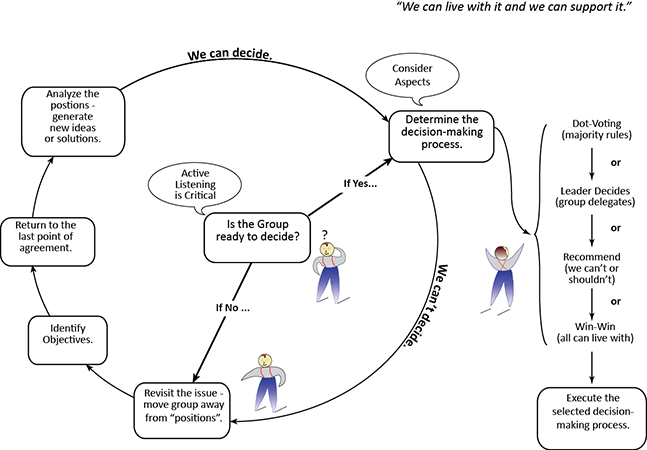September 2010 - The FoCuSeD™ Facilitator eNewsletter

Effective Decision Making | Gary Rush Facilitation
Effective decision-making is crucial. As Facilitators, we are responsible to help groups move past barriers and reach decisions. So, what if a group is evenly split regarding a decision with each side supporting their “solution”? How do you enable the group to reach a consensus-based decision?
I was asked to facilitate a workshop wherein two companies (Company A and Company B) had merged to create a new company. They needed to select a software package for the newly combined company so that they could begin working (the software package was required to begin). They had spent 9 months looking at alternatives and had narrowed it down to 2 choices – Vendor A or Consultant B. They couldn’t decide between the two alternatives because the people from Company A liked Vendor A, but didn’t like Consultant B and the people from Company B liked Consultant B, but didn’t like Vendor A. They were stuck. They asked if I would facilitate a workshop to help them decide between Vendor A or Consultant B. I said, I could but only if they opened it up to more choices. Deciding between only two choices is “win-lose” unless my math is wrong. They said that they had already narrowed it down and I responded that they might have missed something. They agreed.
My assumptions regarding decision-making are:
- Consensus-based decisions are productive and generate the greatest support – they don’t take a long time.
- Voting is not consensus and majority rule is seldom the best choice for deciding.
- Pros and Cons don’t work in a group. It becomes a game.
- This is not a linear process – it is iterative up to the end.
- There are NEVER only 2 choices.
- There is NEVER only 1 right answer.
Get them to Common Ground
The first thing I do, is ask the group what is an acceptable outcome for them – win-win, majority rule, recommend, or delegate. This guides the rest of the workshop process. In this workshop, they all agreed that win-win was the acceptable outcome.
When groups get stuck on two solutions, the first thing you need to do is to move them away from their solutions. This brings the group together on common ground – which is a better starting point. The two most effective ways to do this are:
- Bring them back to common objectives to ensure that they all have the same objectives.
- Bring them forward to an ideal solution – something unattainable yet meeting all of their needs.
I asked the Participants in this workshop to split into two groups (Company A separate from Company B) and describe the ideal solution from their perspective. Both groups described a similar ideal solution. They had been stuck on how to achieve the end result – not what they wanted the end result to look like. The exercise helped the group realize that they were both aiming for the same solution so they began working together.
Generate Many Possible Solutions
To move away from win-lose, you need more than 2 choices. I asked the Participants to generate many possible solutions. To do so, I started with, “Do nothing” and “Do it yourself” (I was giving solutions – a violation of neutrality – but I was certain that they were not practical. I was playing devil’s advocate). They got the concept and generated 5 additional solutions. We now had 9 solutions – no longer win-lose.
Define Objective Criteria
The next step was to use an objective process – developing measurable objective criteria for prioritizing. I asked the Participants to list out their criteria. We then discussed each criterion and refined it until it was measurable. It took 3 hours to define 9 objective criteria. Much of the 3 hours was spent on one criterion – Vendor Viability. It had been the major reason for the deadlock – it was subjective. Defining viability is not objective, but the criterion was apparently very important to the Participants. So, after much discussion, it became evident that what was so important about this criterion to the group was actually experience – how many times had the vendor or consultant implemented this type of software package in their industry. That was a measurable objective criterion.
Prioritize the Solutions using the Objective Criteria
Using the 9 objective criteria, we followed a double-weighted prioritizing process – score the solutions against the criteria, weight the criteria, multiply the weight times the score, and add up the weighted scores. We did this as a group. The Participants discussed each solution relative to the criteria and agreed on scores and weights. We added up the weighted scores and viewed the solutions in rank order. When we finished, the original two solutions were ranked third and fourth. The one they selected was neither of the two they started with. They now had a win-win solution.
Summary
Groups often get stuck on two solutions. The Facilitator’s job is to help them through the decision making process. You do this by:
- Getting them to common ground.
- Generating many possible solutions.
- Defining objective criteria.
- Prioritizing the solutions using the objective criteria.
When you do this, the Participants leave with a win-win solution. ![]()

